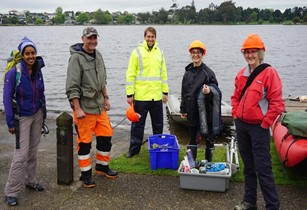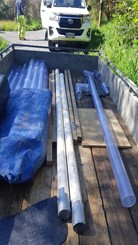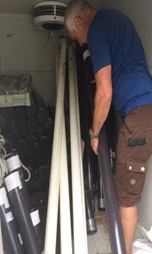Finding Fault: Researchers Team Up To Assess Hamilton’s Seismic Risk And Lake Health
Two science research teams have joined forces to develop a new understanding of earthquake risk and lake health in and around Hamilton using core samples taken from lake beds.
Led by University of Waikato scientists Professor David Lowe and Dr Vicki Moon, the Tephra-Seismites team is studying prehistoric earthquake activity in Hamilton and its surrounding lowlands. Meanwhile the Lakes380 project, led by GNS Science and the Cawthron Institute, is investigating lake history and health in Aotearoa.
“When we realised both research groups needed sediment samples from lakes in the Hamilton lowlands, we decided to team up,” Professor Lowe says.
Last month they began by collecting core samples from three Hamilton lakes: Rotoroa (Hamilton Lake), Rotokaeo (Forest Lake), and Waiwhakareke (Horseshoe Lake). The cores contain sediment up to 20,000 years old.
Uncovering Hamilton’s seismic history
Analysing the layers of sediment that accumulate at the bottom of a lake provide insight into its history over thousands of years. In the Hamilton lowlands, lake sediments include multiple layers of volcanic ash (tephra) deposited through the air by eruptions at volcanic centres including Taupō, Okataina, Tongariro-Ruapehu, Taranaki, and Tuhua (Mayor Island).
The team has found that five tephra layers in the cores show possible signs of liquefaction the phenomenon seen during the Christchurch earthquakes where sediment turns to fluid. The features of those layers mean that one or more local faults may have been responsible for previously unrecognised earthquakes in the Hamilton lowlands over the past 20,000 years.
“Hamilton is known for having a low to moderate earthquake risk; but our research shows that this designation might need to be revised, depending on what we find,” says Professor Lowe.
Around 30 lakes are scattered among Hamilton’s faults, and the cores from these will be used to build up a picture of which faults may have been active in the past.
“By studying the nature of the tephra layers using CT scanning and geotechnical methods, we aim to calculate the intensity of shaking and develop a new understanding of seismic hazard in and around Hamilton,” says Professor Lowe.
The health of lakes in the last 1,000 years
The Lakes380 team, led by Dr Susie Wood at the Cawthron Institute and Dr Marcus Vandergoes at GNS Science, is sampling water and sediments from around 10% of New Zealand’s natural lakes. The team will use water samples to characterise present-day lake health, and sediment samples including cores to show how that health has changed over the last 1,000 years.
The Tephra-Seismites project is supported by the MBIE Endeavour Fund and the Marsden Fund, and Lakes380 is supported by the MBIE Endeavour Fund. The collection of cores from Hamilton lakes is supported by Ngāti Wairere and Hamilton City Council.
 |  |
 |  |

Above: Transparent cores from Waiwhakareke (Horseshoe Lake) showing two tephra seismites (ash layers dislocated and partly liquefied by shaking in an earthquake) within dark brown lake sediment: the upper grey layer, about 3 cm in thickness, is Tuhua tephra (erupted from Mayor Island 7600 years ago); the lower cream-coloured layer, about 1 cm thick, is Mamaku tephra (erupted from Okataina volcanic centre 8000 years ago). Photos: David Lowe


 Hugh Grant: What Is Cloud Migration And How Does It Work
Hugh Grant: What Is Cloud Migration And How Does It Work Property Council New Zealand: Hiwa Recreation Centre Takes Top Award At 2025 Property Industry Awards
Property Council New Zealand: Hiwa Recreation Centre Takes Top Award At 2025 Property Industry Awards Great Journeys New Zealand: Scenic Plus Winter Menu Launched
Great Journeys New Zealand: Scenic Plus Winter Menu Launched Tourism New Zealand: Tourism New Zealand Invites The World To Find Their 100% Pure New Zealand In New Global Campaign
Tourism New Zealand: Tourism New Zealand Invites The World To Find Their 100% Pure New Zealand In New Global Campaign Bill Bennett: Comcom warns 2degrees over satellite marketing
Bill Bennett: Comcom warns 2degrees over satellite marketing Transpower: Major Electricity Development For Western Bay Of Plenty A Step Closer
Transpower: Major Electricity Development For Western Bay Of Plenty A Step Closer


